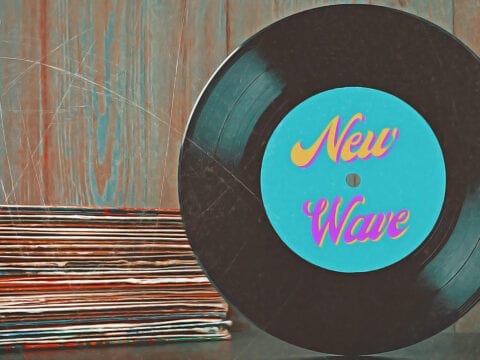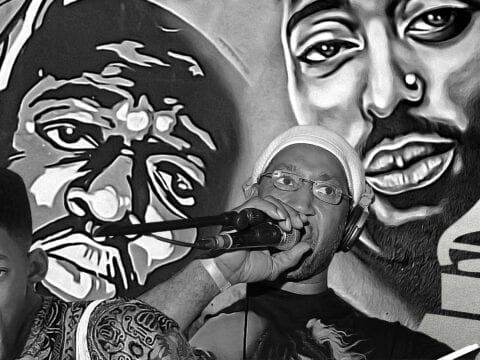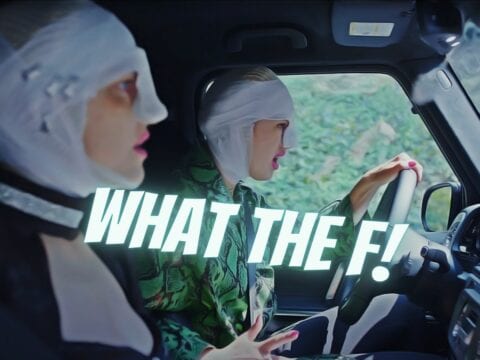
New wave music originated as a more pop-oriented genre to the emergence of punk rock music, hard rock, and heavy metal music in the 1970s. New wave was prominently popular in the United States and the United Kingdom in the late 1970s through the end of the 1980s, though some new wave bands had global popularity and some maintain strong fanbases through the 21st century. New wave was one of the most preeminent forms of pop music during the early years of MTV, which helped significantly bolster its popularity with mainstream audiences.
Though most new wave bands became popular after the initial wave of punk rock popularity, several new wave bands became popular during the same time. Several bands that performed punk rock music in the mid-1970s would incorporate pop elements into their music and be reclassified as new wave bands, with Blondie, the Go-Go’s, and the Pretenders being three notable examples. While many of the first crop of new wave bands had roots in the punk rock scene, this was less common by the early 1980s.
Unlike punk and heavy metal bands, new wave bands largely had the support of major music labels and many artists would achieve much more mainstream popularity. Numerous new wave singles also charted on Billboard’s Dance Club Songs chart in the United States, while the songs received additional exposure in nightclubs.
Other artists like blues band ZZ Top, rock band J. Geils Band, and heavy metal band Def Leppard would successfully incorporate elements of new wave into their music to great commercial success in the 1980s. Other artists, such as the Cure and Depeche Mode, began their careers with a new wave sound and moved into different rock subgenres.
We will now begin to explore the history of new wave music from its origins to the late 1980s.
How Did New Wave Music Begin?
Most new wave artists utilized synthesizers extensively in their music, and the sound of new wave grew in popularity as the use of the synthesizer became more prominent in pop music. When the synthesizer was developed in the 1960s and early 1970s, it was most commonly used as an instrument by progressive rock bands such as Yes, Emerson, Lake & Palmer, and Pink Floyd. Later in the 1970s, synthesizers became more affordable and portable, and as a result, an increasing number of musicians began using them.
The “artificial” quality of synthesizers led to something of a backlash against the instrument by some heavier rock bands. Most notably, Queen noted that no synthesizers were used in the liner notes of their 1973 debut album through their 1978 album, Jazz. By the early 1980s, synthesizers would become so common in rock music that Queen would back off this position starting with their 1980 album The Game and would use synthesizers in their music for the rest of their career.
By the late 1970s, the synthesizer would become central to the sound of numerous rock bands, which was not the case for certain genres of rock music like heavy metal or punk rock (which rarely utilized synthesizers at this time). Music with that distinctive synthesizer sound was dubbed “new wave music” by rock critics to differentiate those artists from punk rock bands (although some critics also considered punk as part of new wave music) and to indicate the sonic difference between pre-1970 rock and roll and then-modern rock music.
A major band that had a significant influence on the sound of new wave was the English group Roxy Music. At the time Roxy Music released their self-titled debut album in 1972, the group was largely perceived as a glam rock band, but Roxy Music significantly featured synthesizers in their music, first by noted musician Brian Eno (on the band’s first two albums) and then afterward by Eddie Jobson. Roxy Music became a very popular band in the United Kingdom with ten Top 10 hits and was noted by the songwriting talent of frontman Bryan Ferry. After leaving Roxy Music, Eno would produce albums recorded by new wave bands Talking Heads and Devo. Roxy Music disbanded in 1983 after the release of the band’s best-selling album, Avalon.
Another major influence on new wave music was David Bowie, who released three albums that he recorded with Brian Eno—Low (1977), “Heroes” (1977), and Lodger (1979)—that were later dubbed Bowie’s “Berlin Trilogy.” These three albums significantly utilized electronic music in their production. Some of the new wave bands that almost exclusively created their music by synthesizers have also cited German electronic music pioneers Kraftwerk as a major influence, particularly the group’s 1974 album Autobahn. At that time, many musicians in West Germany had been experimenting with electronic music and synthesizers which would later be dubbed “Krautrock” in the United Kingdom.
Who Invented New Wave Music?
Because new wave music evolved from other music genres, there is no critical consensus on what the “first” new wave band was. For example, Blondie’s third album, Parallel Lines, was released in September 1978 and was almost entirely devoid of the punk influences on the band’s first two albums. Though the album’s biggest hit was the disco-influenced “Heart of Glass,” Parallel Lines features other songs with the new wave sound, including “One Way or Another.” Parallel Lines was successful globally and was the best-selling album in the United Kingdom in 1979.
English musician Gary Numan is generally considered by critics as one of the first major new wave artists to achieve commercial success. Numan pioneered numerous synthesizer and audio effects and adopted a robotic persona as the frontman of the new wave band Tubeway Army. The band had the first new wave hit to top the UK charts with the 1979 single “Are ‘Friends’ Electric?” That same year Numan released a solo album, The Pleasure Principle, that featured another number one hit in the UK, “Cars,” which was almost entirely performed by synthesizers. “Cars” also was a number one hit in Canada and peaked at number nine in the United States. Numan would continue to chart hits throughout the 1980s in the UK, though he did not have another hit in the United States.
In the United States, Los Angeles band the Knack achieved the top-selling single of the year with their 1979 debut single, “My Sharona,” a 1960s throwback song that was Capitol Records’ fastest-selling debut single since the debut single by the Beatles in the United States “I Want to Hold Your Hand.” Though the Knack was never able to equal that initial success, it marked one of the most significant moments when a new wave band experienced national commercial success.
Some of the other earliest successful new wave artists include:
Talking Heads – Talking Heads formed in 1975 in New York City, and their first live performance was opening up for the Ramones at the famed music club CBGB in June 1975. The band, which primarily consisted of main songwriter David Byrne (vocals, guitar), Chris Frantz (drums), Tina Weymouth (bass), and Jerry Harrison (keyboards), released their first album, Talking Heads: 77, in September 1977. That album featured the minor hit “Psycho Killer,” and Talking Heads would ultimately only chart two songs in the Billboard Top 40: 1978’s “Take Me to the River” and 1983’s “Burning Down the House.” However, Talking Heads received critical acclaim for their increasingly experimental approach to pop music, and by the time the band disbanded in 1988, they were considered significantly influential. In addition to Talking Heads, Weymouth and Frantz also formed the new wave band Tom Tom Club, which had a Top 40 hit with 1981’s “Genius of Love.”
Devo – Though the Ohio band Devo was not a major commercial success, the surrealist humor in their electronic music has made them one of the most memorable new wave bands. Devo formed in the early 1970s, but the band did not issue their first album until 1978’s Q: Are We Not Men? A: We Are Devo!, which featured the band’s unique rendition of the Rolling Stones classic “(I Can’t Get No) Satisfaction.” Their third album, 1980’s Freedom of Choice, was their most successful and contains the hit “Whip It,” known for its memorable music video that received significant airplay on MTV.
The Cars – Formed in Boston, Massachusetts by songwriters/vocalists Ric Ocasek and Benjamin Orr in 1976, the Cars were one of the most commercially successful new wave bands. Their self-titled debut album was released in 1978. The Cars had 14 Top 40 singles in the United States from 1978 to 1987. The Cars also released several popular music videos, including the one for their hit “You Might Think,” which won the first MTV Video Music Award for Video of the Year. The band’s biggest hit, the ballad “Drive,” was one of the centerpiece songs of the Live Aid benefit in 1985.
The Police – Formed in London by singer/bassist Gordon Sumner (known by the stage name Sting) and drummer Stewart Copeland and later adding guitarist Andy Summers, the Police crossed several genres in their music, including punk and reggae. The trio would have ten Top 10 singles in the UK, five of which hit number one. Their 1983 single “Every Breath You Take” hit number one in both the United Kingdom and the United States. Though they were active for less than ten years, the Police are one of the best-selling artists of all time, and Sting would go on to an extremely successful career as a solo musician.
B-52s – When the B-52s formed in Georgia with Fred Schneider (vocals), Kate Pierson (vocals), Cindy Wilson (vocals), and multi-instrumentalists Ricky Wilson and Keith Strickland in 1976, their unique lineup and humorous lyrics won them an underground fanbase. Their 1979 self-titled debut album featured the minor hit “Rock Lobster,” and though they had several other singles and albums that charted. It was not until two songs off the band’s 1989 album Cosmic Thing, “Love Shack” and “Roam,” that they would have bigger hits—both hit number 3 on the Billboard Hot 100 chart.
Elvis Costello – By the time Elvis Costello released his debut album My Aim is True in July 1977 he had been a veteran of the English music scene for seven years. While he would chart several successful singles in the UK, he would not have a Top 40 hit in the United States until 1983’s “Everyday I Write the Book,” which would later be eclipsed by the success of his 1989 single “Veronica” (which hit number 19). Nonetheless, Costello would earn a loyal international fanbase and become recognized for his many collaborations with other artists.
Infamously, Costello and his then-backing band, the Attractions, appeared on Saturday Night Live in 1977 when the intended musical guests, punk band the Sex Pistols, had to bow out because of visa issues. Though the band was supposed to perform their single “Less Than Zero” as their second song, Costello had his band abruptly switch to the song “Radio Radio”—which was critical of the radio industry—instead. Costello was subsequently banned from the show, and the controversy helped his popularity in the United States. He would later team with the Beastie Boys to recreate the moment on Saturday Night Live‘s 25th-anniversary special.
What was the Second British Invasion?
The launch of MTV in the United States in August 1981 led to significant success for many new wave musicians who now had a greater ability to market their music through creative music videos. The first video to play on MTV was a new wave song by the Buggles titled “Video Killed the Radio Star.” The song was an appropriate choice because it prophetically surmised how music videos would dominate the music industry. However, one of the initial challenges of the fledgling network was that the library of music videos was limited. A significant number of videos that the network did have the air rights for were from musicians from the United Kingdom, so their videos went into heavy rotation. American record distributors would see from sales data that sales of certain artists’ albums would spike in areas that broadcast MTV after their music videos appeared on the channels.
Many British new wave bands achieved success on the Billboard charts in the United States but initially became popular because of their music videos, including the Human League (“Don’t You Want Me”), A Flock of Seagulls (“I Ran So Far Away”), Billy Idol (“Eyes Without a Face”), Spandau Ballet (“True”), Bananarama (“Cruel Summer,” “Venus,” and “I Heard a Rumour”), Eurythmics (“Sweet Dreams Are Made of This,” “Here Comes the Rain Again,” and “Would I Lie to You?”), ABC (“Poison Arrow,” “The Look of Love”), Pet Shop Boys (“West End Girls,” “Always on My Mind”), and Culture Club (“Do You Really Want to Hurt Me,” “Karma Chameleon” and others) among many other artists. The success of UK artists during the early 1980s was dubbed the “Second British Invasion” after the mid-1960s “British Invasion” popularity of British groups like the Beatles and the Rolling Stones in the United States.
The most successful United Kingdom new wave band during this period was Duran Duran, which would have 15 Top 40 singles in the United States from 1982 to 1993, including two number ones (“The Reflex” and “A View to a Kill”). Nick Rhodes (keyboards, synthesizers) and John Taylor (bass, guitars) formed Duran Duran in Birmingham, England in 1978. Drummer Roger Taylor (no relation to John) joined in 1979 and vocalist Simon Le Bon and guitarist Andy Taylor (also no relation to either other Taylor) followed in 1980.
Duran Duran’s 1981 self-titled debut album charted four songs in the United Kingdom (including the hit “Girls on Film”), but failed to gain notice in the United States. However, the band’s second album, Rio, became an international bestseller with two major hits, “Hungry Like the Wolf” and “Rio,” both of which were accompanied by high-budget music videos that received substantial airplay on MTV. In addition to the group’s photogenic looks, Duran Duran’s synth-heavy, hook-filled music was popular in their original issues as well as dance remixes. The group was being referred to as the “Fab Five” in reference to their massive popularity in comparison with the original “Fab Four,” the Beatles.
After achieving other big hits in both the United States and the United Kingdom (including “A View to a Kill,” the title song to the 1985 James Bond movie), the band splintered after Roger Taylor left because of exhaustion and Andy Taylor departed acrimoniously. Duran Duran continued as a trio and continued to release successful albums and singles through the early 1990s. Duran Duran continues to tour and record and is arguably the most successful new wave band in history.
Why Were So Many New Wave Musicians One-Hit Wonders?
The term “one-hit wonder” is used to refer to musicians who have achieved just a single Top 40 hit, particularly if that hit song reached the top 10. Though the term has been applied to pop musicians dating back to the 1950s, the phrase grew more popular in the 1980s because of the number of new wave artists that seemed to have short-lived careers.
Many new wave artists had one top-selling song in the United States and were unable to follow up with a second Top 40 hit. These artists include the Buggles (“Video Killed the Radio Star”), M (“Pop Muzik”), Devo (“Whip It”), The Vapors (“Turning Japanese”), Tommy Tutone (“867-5309/Jenny”), and Toni Basil (“Mickey”). Other new wave musicians like Gary Numan, Soft Cell, Dexys Midnight Runners, Bow Wow Wow, Talk Talk, Frankie Goes To Hollywood, and Kajagoogoo had just one hit in the United States but had several additional hits in other countries, particularly in the United Kingdom or Australia. Also, some new wave bands like the Knack are inaccurately labeled as “one-hit wonders” even though they had more than one Top 40 hits (“My Sharona,” “Good Girls Don’t,” and “Baby Talks Dirty”).
In several cases, the one hit in question was bolstered by a memorable music video that had heavy rotation on MTV, which identified the artist with that particular imagery and song. When subsequent videos by that particular artist did not receive as much airplay, the artist became heavily identified by that lone hit and cemented the public image of that artist.
For example, the Norwegian new wave band A-ha is often regarded as a one-hit wonder in the United States because of the band’s 1985 number one hit, “Take on Me,” which has a very popular music video that won six awards at the 1986 MTV Video Music Awards. However, that same year A-ha had a second Top 40 hit in the United States, “The Sun Always Shines on T.V.” A-ha also had eight Top 10 singles in the United Kingdom and 19 in their native Norway, which demonstrates that the band was not a one-hit wonder in any of those markets. As new wave music expanded across the globe, many artists were much more successful in their home countries than they appeared to be in the United States or the United Kingdom.
What Happened to New Wave Music?
Like most subgenres of rock and roll music, the trend of new wave music was eventually overcome by newer trends. Major new wave bands like Talking Heads, the Cars, and the Police had disbanded by the late 1980s, and many others with more limited success also broke up when their albums and singles were no longer commercially successful. At that time, hard rock and “hair metal” bands like Def Leppard, Guns N’ Roses, Bon Jovi, Poison began having hit singles in the United States as well as more traditional pop artists like Michael Jackson, Madonna, Paul Abdul, Debbie Gibson, New Kids on the Block, Janet Jackson, George Michael, and Whitney Houston. By the early 1990s, genres like grunge rock and rap had increasing popularity among mainstream audiences.
New wave had a significant influence on electronic music, and it is still very common for modern DJs to remix or sample music from new wave artists. Today, many new wave bands continue to produce new music and commonly participate in package tours with several new wave bands taking part.





